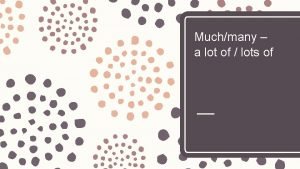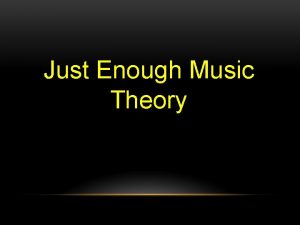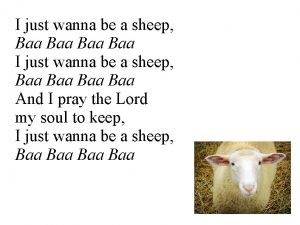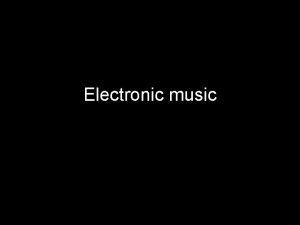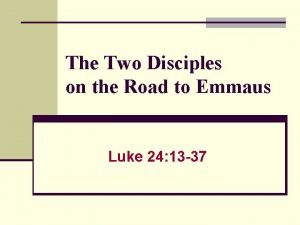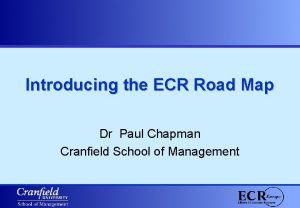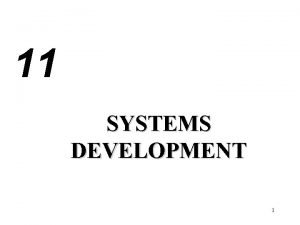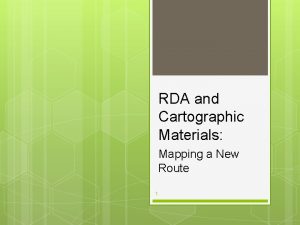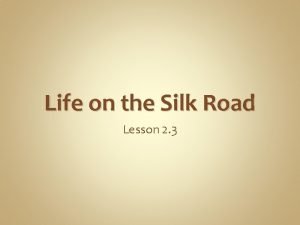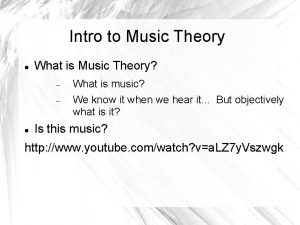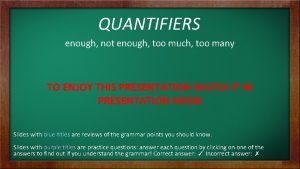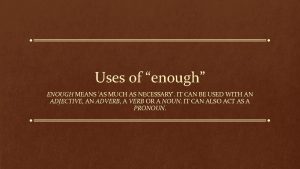Just Enough Music Theory Road Map for the








































- Slides: 40

Just Enough Music Theory

Road Map for the Week Monday Masters of the musical university – the octave, scales, keys Tuesday Intervals in music and how to create chords Wednesday Choosing chords – Circle of 5 ths Thursday Chord substitution - chord alternations - chord extensions Friday Arranging – composing – where to go from here

GOALS By the end of the week you should be able to: Understand the overtone series and its use Spell the chords on the diatonic scale Know how to create chord progressions Know how to interpret chord symbols Use chord extensions to create the sound you want

The Handouts you don’t have! www. Bill. Troxler. c om Handouts Just Enough Music Theory Reach me at: Bill. Troxler@gmail. com A WONDERFUL reference book for this subject is Edly’s Music Theory for Practical People http: //www. edly. com/ locally or Amazon

Music Begins when something vibrates air……. a reed…. . human lips…. . vocal cords…. . a str an animal skin…. metal plate…block of wood The vibrations are perceived by the brain as sound – musical tones. We order those tones based upon how fast or slow the vibrations occur – in cycles per second or Hertz (Hz) A musician's job is to manipulate the four major audi attributes of musical tones: pitch - loudness - duration - timbre Musical tones are psychoacoustic. That’s why music is SO powerful and so

The Range of Musical Tones Name of Tone Hertz C 0 16 C 1 32 C 2 64 C 3 128 C 4 (middle C) 256 C 5 512 C 6 1, 024 C 7 2, 048 C 8 4, 096 C 9 8, 192 C 10 16, 384 The table is in “scientific” not “musical” pitch. C 4 in musical pitch is

Masters of the Musical Universe The Octave – range of tones The interval between one musical pitch and another with half or do frequency is called the OCTAVE. The octave is sometimes called t Scales - order or tones A scale divides the octave into a specific number of tones or pitches – usually between 5 and 31 pitches. A scale ALWAYS imposes a specific order to the pitches it contains Keys - A sense of belonging - population without order Keys tell you which tones within the octave are used in a piece of music. The scale we select within a key determines the relationships among the tones of that key and thereby allows us to construct melody and its supporting harmony.

Masters of the Musical Universe – the Octave The term “octave” comes from the Latin word “octavus” which means “eighth”. “Octave” describes this doubling of frequency because span of frequencies natural divides into eight parts: Do - Re - Me - Fa - So - La - Ti - Do These eight divisions of the octave are a phenomenon o They are the basis for all Western music

The Overtone Series Look at how guitar strings vibrate Listen to the Overtones Across Six Octaves

The Overtone Series Used in Music – 2001 –Close Encounters - NBC Sunrise begins with a sustained low C the double basses, contrab and organ. Prelude to the brass fanfare of "dawn" motif - in interv fifth and octave, as C 1–G–C 2 - also called the Nature-motif The motif is a part of the first five notes of the natural overton The major third is immediately changed to a minor third, which is t played in the work (E flat) that is not part of the overtone series The Music Close Encounters Sunrise in Performance NBC

The Musical Scale A scale divides the octave into a number of tones - Scales exhibit these cha Order Scales arrange their pitches in a specific order Number In theory there is no limit to the number of pitch divisions that can b to an octave. The number of divisions used in Western music rang five to twelve. Experimental work is being done with as many as 3 Indian classical music divides the octave into 22 divisions. Western music describes the divisions of the octave as “steps”. These st be whole steps or half steps. Look at a piano key board. The black and are these whole and half steps. The first tone of a scale is called the “tonic” or “root”. It usually is the name of the key

CENTS The cent is a unit of measure used for musical interva The octave can be divided a chromatic scale of 12 semitones. Each of these twelve semitones is further divided into 100 cents. One cent is too small to be heard between successive tones. Humans can discern about 5 cents and no smaller inte That's about 1/10 of a semitone.

Cents across the octave

Whole & Half Steps The pattern of steps in a major scale is: W W H W W W H

More Scales than a Fish! Review the handout on the website to see the vast number of pos Melodic players should master these scales ………… Ionian mode scales in the keys of C, D, G, A and E major In the key of “C” that’s: C D E F G A B Natural minor Scales in the keys of Eminor, A minor, D minor a In the key of “A minor” that’s: A B C D E F G Major Pentatonic in the keys of C, G, D, A, E and F In the key of “C” that’s: C D E G A More info here……. .

Intervals Pitches on scales are given two kinds of names. letter names [A- B – C – D – E – F - G]. a number that describes their relationship the tonic Scal e do re me fa so la ti do Interv Uniso Secon Third Perfe Sixth Sevent Octav h al n d 3 rd ct ct fifth 6 th e 7 th name 2 nd fourth 5 th 4 th

Intervals What about the black keys? ? ? The major intervals become minor intervals The perfect intervals become diminished intervals Scale do ra me mi Se le tie do Interva Unison Minor Diminish Minor Octave ed ed Secon Third Sixth Sevent l name d 2 nd 3 rd fourth 4 th fifth 5 th 6 th h 7 th

Making Chords A chord is a stack of at least three tones played simultaneous When chords are built on the diatonic scale used in most traditional music, three forms are created: major - minor - diminished These stacks of three tones are called “triads”. Additional tones are often added to the basic triads. These additional tones are called “Chord Extensions”. The sounds created by chord extensions are the essence of many styles of musi

Chord Formulas: The Major Chord To form a major chord Begin with the tone that names the chord. Add a major 3 rd above that fundamental tone Add a perfect 5 th above the fundamental tone. Examples: The C-major chord is [C or Cmaj ] is spelled C – E – G. The G-major chord [G or Gmaj ] is spelled G – B - D The D-major chord [CD or Dmaj ] is spelled D – F# - A OR…. . A major chord is a major 3 rd PLUS a minor 3 rd

Chord Formulas: The Minor Chord To form a minor chord Begin with the tone that names the chord. Add a minor 3 rd above that fundamental tone Add a perfect 5 th above the fundamental tone. Examples: The C-minor chord [Cm or Cmin] is spelled C – Eb – G The G-minor chord is spelled [Gm or Gmin] G – Bb - D The D-minor chord is spelled [Dm or. Dmin] D – F - A OR…. A minor chord is a minor 3 rd PLUS a major 3 rd

Chord Formulas: The Diminished Chord To form a diminished chord Begin with the tone that names the chord. Add a minor 3 rd above that fundamental tone Add a diminished 5 th above the fundamental tone. Examples: The C-diminished chord [Cdim or C°] is spelled C – E The G-diminished chord is spelled [Gdim or G°] G – Bb The D-diminished chord is spelled [Ddim or D°] D – F OR…. A diminished chord is a minor 3 rd PLUS a minor 3 rd

Chord Formulas: The Augmented Chord To form an augmented chord Begin with the tone that names the chord. Add a major 3 rd above that fundamental tone Add an augmented 5 th above the fundamental tone. Examples: The C-augmented chord [Caug or C+] is spelled C – E The G-augmented chord is spelled [Gaug or G+] G – Bb The D-augmented chord is spelled [Daug or D+] D – F OR…. An augmented chord is a major 3 rd PLUS a major 3 rd

Chord Symbols Major Chords: Maj M Δ Gmaj GM GΔ Minor Chords: min m Dmin Dm DDiminished Chords: dim o ° Adim Ao A° Augmented Chords: aug +

Slash Chords Sometimes a specific tone is to be played as the lowes In the triad. To indicate this a slash “/” is used following the chord n C/B means play a C chord with “B” as the lowest tone. A walking bass on guitar is often notated this way: C C/B C/A C/G and then off to a new chord

Chord Nomenclature Music notation often uses the letter names of the chords: In C major – C Dm Em F G Am Bdim In conversation, in studio work and in text, chords symbols are used The symbols used are Roman numerals representing the interval of the scale on which the chord is built In C major - I ii iii IV V vi vii°

Chord Progressions Chord Progression…… Chord Changes…. . Harmonic Motion…. . Harmonic Rh The most basic chord progression in a major key is I – IV - V Key of C major: C - F - G Key of G major: G - C - D The “circle of 5 hts” is a tool for determining chord progressions in

Circle of 5 ths

Circle of 5 ths – Key Signatures Add one sharp to each Key as you move clockwise around the circle. Which sharp to add is determined by the scale pattern of: W W H W W W H The order of sharps to add is: F# C# G# D# and so forth

CIRCLE OF 5 THS – KEYS Anticlockwise the movement is in 4 ths. Add flats instead of sharps. More info here…….

Circle of 5 ths – Relative Minors

Circle of 5 ths – the chord box

The Circle of 5 ths – Chord Progressions What you need to know is here! There is much more to say about chord progressions. Chord extensions and use of intra-modal chords really enliven a performance. But, those topics are beyond a week long class. We’ll take just a peek at these two subjects

Suspended and other useful chords A suspended chord replaces the 3 rd with either a 4 th or a 2 nd. Dsus 4 is spelled” D G A Often this chord will be played as D 7 sus 4 spelled D G A C Dsus 2 is spelled” D E A Often this chord will be played as D 7 sus 4 spelled D E A C The “minor 7 th chord is often useful. An example is Dm 7 spelled D F A C Rearrange the tones of the Dm 7 chord in this order – F A C D chord gets a new name: F 6. What to call it depends upon the

Chord Extensions Often a fourth tone is added to the triad. It’s most often the flatted 7 th of the scale. These are called “ 7 th chords “ and written as C 7, D 7, G 7. Or as numeric notation as V 7. We say “ C seven” to identify th On occasion the major 7 th of the scale is added. These chords are called “major 7 th chords”. They are written as Cmaj 7, Dmaj 7, Gmaj 7. More tones can be added to a chord beyond 7 th of the scale. These are called “chord extensions”.

Chord Extensions – 9 th, 11, th, 13 th A 9 chord is spelled: 1, 3, 5, b 7, 9 A C 9 chord is spelled: C E G Bb D An 11 chord is spelled: 1, 3, 5, b 7, 9 A C 11 chord is spelled: 1, 3, 5, b 7, 9, 11 A C 13 chord is spelled: 1, 3, 5, b 7, 9, 11, 13 Chord extensions can sound “muddy”. To fix that some ton are often left out of the chord. Those chords are call “add c

Add Chords If any tone other than the 7 th is included in a chord the result is called an “add chord” A Cadd 9 chord or C+9 is spelled: C E G D A Cadd 11 chord or C+11 is spelled: C E G F ANY of the twelve tones of the chromatic scale may be added to a basic triad The G 7+b 5 chord is spelled: G B Db F(natural)

Intra-Modal and Mixed Mode Music The musical scale does not have to start on DO. It can start on any tone of the diatonic scale When a scale begins on a tone other than DO the result is called “a mode of the diatonic scale”. The seven modes of the scale are titled: Ionian, Dorian, Phrygian, Lydian, Mixolydia, Aeolian, and Locrian Each mode has a unique sound and chord selection Music can shift modes and mix modes. One mode can borrow chords from another mode. Hear and learn about the modes

Ionian Mode Tone C D E whol Step e e Solfe ge d o re m e F G A B hal f whol e half fa Sample 1 of Ionian Mode - Visitors s o la ti

Aeolian Mode Solfege AAeolian EAeolian BAeolian Step ti do re A B C D E F# G A B C# D E la whol e hal f Sample 1 Aeolian Mode whol e m e E fa so F G B C D F# G A whol e hal f whol e Sample 2 Aeolian Mode whole

That’s it!!!! Hope you enjoyed the class and will find a place in your music for the information!!! Don’t forget to complete the evaluation form!!! WWW. Bill. Troxler. com Bill. Troxler@gmail. com
 Our failing schools enough is enough
Our failing schools enough is enough Too enough not enough
Too enough not enough Im good enough i'm smart enough
Im good enough i'm smart enough Our failing schools enough is enough summary
Our failing schools enough is enough summary Music music music
Music music music Lisa is 10 centimeters taller than
Lisa is 10 centimeters taller than Paved road vs unpaved road
Paved road vs unpaved road Who is the first person to arrive at juliet's tomb?
Who is the first person to arrive at juliet's tomb? Music theory map
Music theory map I just wanna be a sheep sheet music
I just wanna be a sheep sheet music Romantic time period
Romantic time period It refers to the number of individual musical lines
It refers to the number of individual musical lines A music that employs electronic musical instruments
A music that employs electronic musical instruments Ilocano instruments
Ilocano instruments Road to emmaus map
Road to emmaus map Thesis and roadmap
Thesis and roadmap Where is the thesis statement located in the introduction
Where is the thesis statement located in the introduction Thesis and road map
Thesis and road map Mol road map
Mol road map Reading road map
Reading road map Ecr road map
Ecr road map Which statement describes zheng he’s travels?
Which statement describes zheng he’s travels? Road map of cellular respiration
Road map of cellular respiration A road map indicating the direction of systems development
A road map indicating the direction of systems development 10 step km road map of amrit tiwana
10 step km road map of amrit tiwana Thesis development and road map
Thesis development and road map Thesis statement examples
Thesis statement examples Thesis statement road map
Thesis statement road map Silk road mind map
Silk road mind map Rda map
Rda map Thesis road map
Thesis road map Sql road map
Sql road map Akkalkot to kurnool bharatmala project map
Akkalkot to kurnool bharatmala project map Thesis development and road map
Thesis development and road map Road map thesis statement
Road map thesis statement Silk road map activity
Silk road map activity Linux road map
Linux road map Roadmap bdm
Roadmap bdm Curriculum planning
Curriculum planning Hess strand jobs
Hess strand jobs A road map for digital forensic research
A road map for digital forensic research

